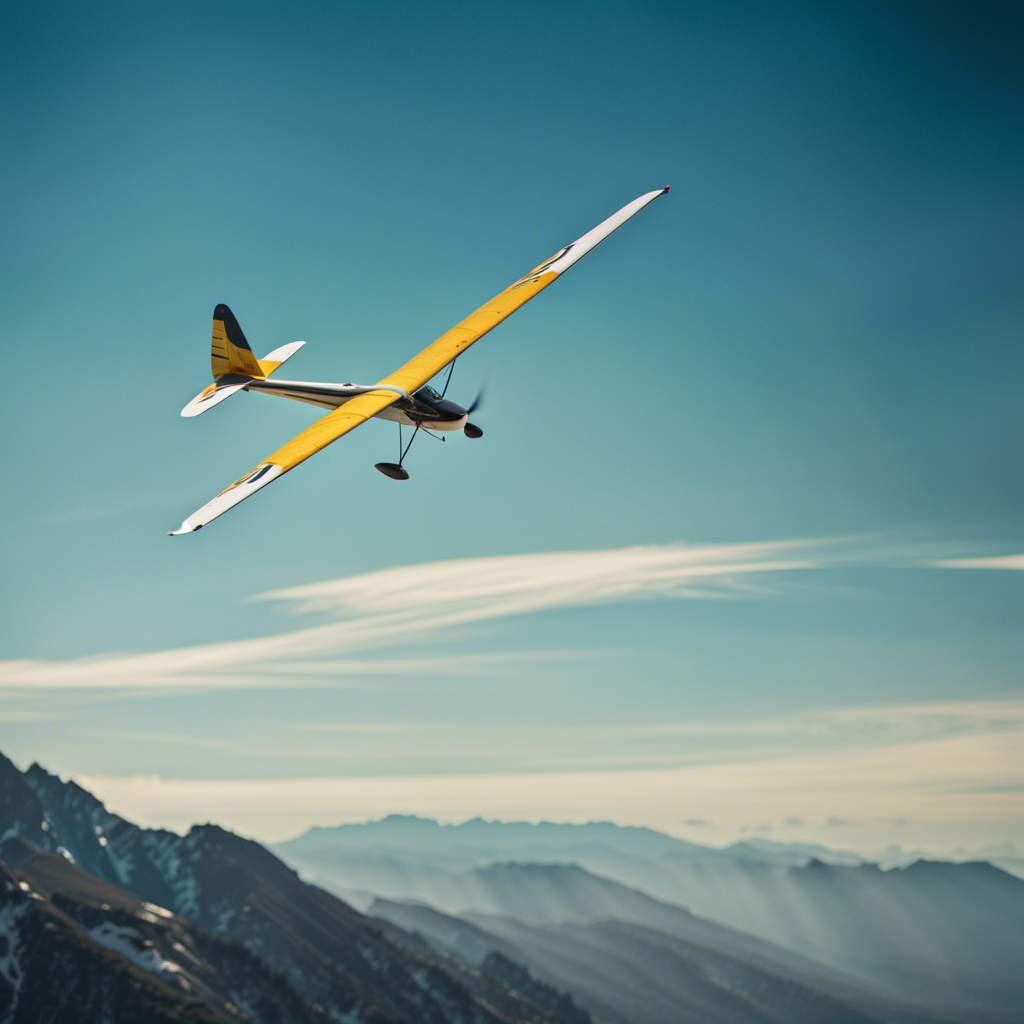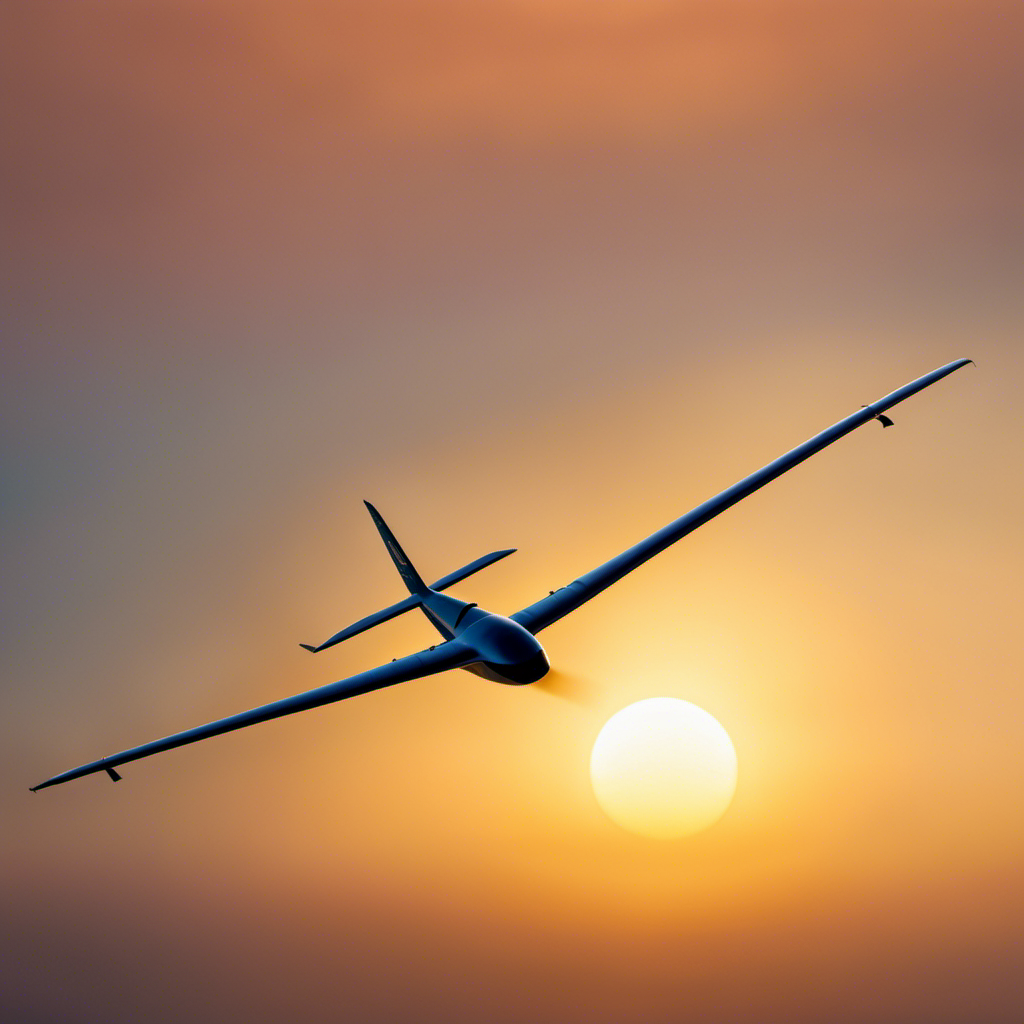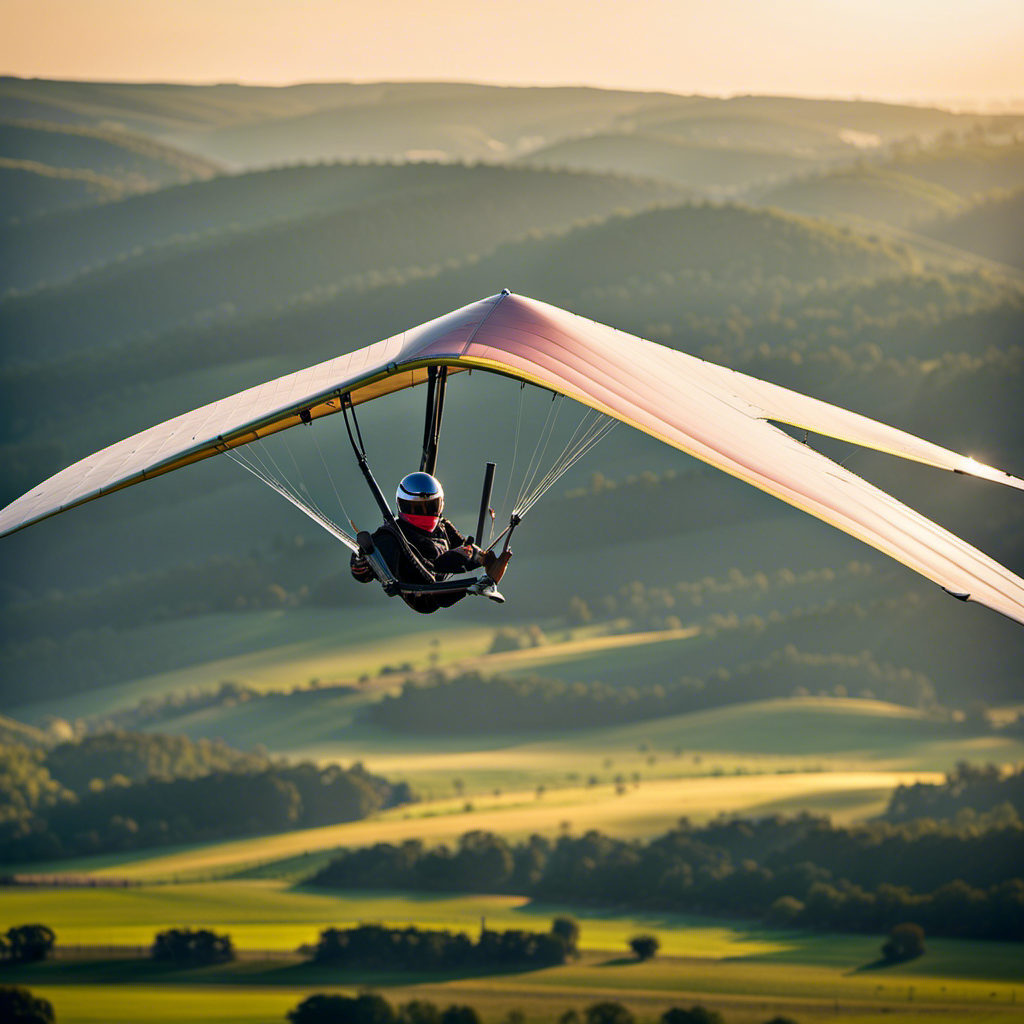Are you unsure about the exciting world of flying through the air? Do you think it’s just a leisurely activity for the timid? It’s time to rethink.
This comprehensive overview of the sport of gliding will show you why it’s anything but ordinary. From its rich history to the various types of gliders, you’ll discover the thrill of soaring through the skies.
With insights into the equipment, techniques, competitions, and safety procedures, this article will give you a knowledgeable and objective perspective on the future of gliding.
Key Takeaways
- Gliding competitions involve various elements such as navigation, endurance, discovery, distance, speed, aerobatics, and racing.
- Safety and emergency procedures in gliding are crucial, including pre-flight checks, emergency landings, dealing with unexpected weather, and swift crisis response.
- Joining gliding clubs and associations offers benefits like camaraderie, learning opportunities, access to resources, competitions and events, and support and guidance from experienced pilots.
- The future of gliding is being shaped by advancements such as electric gliders, autonomous systems, lightweight materials, virtual reality simulators, and the use of sustainable energy sources.
History of Gliding
Now, let’s delve into the fascinating history of gliding and how it has evolved over the years.
Gliding, also known as sailplane flying, traces its roots back to the late 19th century. It all started with the Wright brothers’ experiments with glider prototypes, which eventually led to the invention of the first successful airplane.
The early years of gliding were marked by significant advancements in aerodynamics and design. Pioneers like Otto Lilienthal and Percy Pilcher made significant contributions to the development of gliding as a sport.
Over time, gliders became more sophisticated, incorporating modern materials and technologies. Today, gliding has become a popular recreational activity, as well as a competitive sport.
Now, let’s explore the different types of gliders and their unique characteristics.
Types of Gliders
You might be interested in knowing the different types of gliders available for your flying adventures.
Gliders come in various shapes and sizes, each designed to suit different flying conditions and preferences.
The most common type is the sailplane, which is a lightweight aircraft without an engine. Sailplanes rely on thermal updrafts and air currents to stay airborne.
Another type is the motor glider, which combines the best of both worlds by having a small engine for takeoff and climbing, and then switching to gliding mode. This versatility allows motor gliders to cover longer distances.
There are also aerobatic gliders, specially designed for performing breathtaking maneuvers in the air.
Now that you know about the types of gliders, let’s move on to exploring the essential gliding equipment.
Gliding Equipment
To enhance your gliding experience, it’s important to have the right equipment. The key piece of equipment you’ll need is a glider, which is a specialized aircraft designed for soaring through the air without an engine. Gliders come in various shapes and sizes, from single-seat to multi-seat models. You’ll also need a parachute for safety, as well as a helmet and a comfortable, snug-fitting harness to secure yourself in the cockpit. Additionally, you’ll want to have a reliable altimeter to measure your altitude, a variometer to indicate your rate of climb or descent, and a compass for navigation purposes.
Now that you’re equipped with the necessary gear, let’s move on to the exciting takeoff and landing techniques.
Transitioning from gliding equipment to takeoff and landing techniques, it’s crucial to master these skills in order to safely navigate the skies while gliding.
Takeoff and Landing Techniques
When it comes to takeoff methods in gliding, there are three main techniques to consider.
Aerotow launches involve being towed into the air by a powered aircraft, providing a smooth and controlled ascent.
Winch launches, on the other hand, utilize a powerful winch to rapidly pull the glider into the air, offering a quick and exhilarating takeoff.
Lastly, self-launching gliders have their own built-in engines, allowing them to take off independently, providing flexibility and convenience for the pilot.
Aerotow launches
For aerotow launches, it’s crucial to maintain a steady climb rate to ensure a successful takeoff. This type of launch involves a glider being towed into the air by a powered aircraft. As the glider gains altitude, it gradually releases the towline and continues on its own. To help you understand the components of an aerotow launch, here is a table outlining the key elements:
| Component | Description |
|---|---|
| Towplane | Powered aircraft responsible for towing the glider |
| Towline | Cable connecting the towplane and the glider |
| Release | Mechanism used to detach the towline from the glider |
Now that you have a basic understanding of aerotow launches, let’s move on to the next section about ‘winch launches’. This method involves using a winch to launch the glider into the air without the need for a towplane.
Winch launches
If you’re looking for an alternative to aerotow launches, winch launches provide a different method of getting your glider into the air.
With a winch launch, a powerful winch is used to rapidly pull the glider down the runway and into the sky. The winch is typically located at the end of the runway and uses a long cable that is attached to the glider’s nose.
As the winch rapidly reels in the cable, the glider gains speed and lift, allowing it to take off. This method is often favored by glider pilots who enjoy the thrill of a fast and dynamic launch.
It is important to note, however, that winch launches require a high level of skill and experience to execute safely and effectively.
Transitioning to the next section, self-launching gliders offer an even more independent way of getting airborne.
Self-launching gliders
To experience the freedom and convenience of launching on your own terms, self-launching gliders allow you to take control of your flight from start to finish. Here are three reasons why self-launching gliders are a popular choice among glider pilots:
-
Versatility: With a self-launching glider, you have the flexibility to launch from any suitable runway or field, eliminating the need for a winch or tow plane. This means you can explore new locations and enjoy the thrill of soaring in different environments.
-
Independence: Self-launching gliders are equipped with an engine that allows you to take off without the assistance of external equipment. This independence gives you the freedom to fly whenever you want, without relying on the availability of winch operators or tow pilots.
-
Efficiency: Self-launching gliders are designed to efficiently convert engine power into altitude, allowing you to reach soaring conditions quickly and with less fuel consumption. This means you can spend more time soaring and less time climbing, maximizing your flying experience.
With the knowledge and control gained from self-launching gliders, you are now ready to explore the next section on soaring techniques.
Soaring Techniques
You can improve your soaring techniques by practicing proper weight shifting and utilizing thermals effectively.
Weight shifting is crucial in gliding as it allows you to control the aircraft’s attitude and maintain stability. By shifting your weight smoothly and accurately, you can adjust the aircraft’s pitch, roll, and yaw. This skill is honed through practice and experience.
Additionally, understanding and utilizing thermals is essential for successful soaring. Thermals are rising columns of warm air that can provide lift for gliders. By locating and flying within thermals, you can gain altitude and extend your flight time. Learning to read the signs of thermal activity and effectively maneuvering within them will greatly enhance your soaring abilities.
Now, let’s delve into the exciting world of cross-country flying.
Cross-Country Flying
Exploring new territories and navigating unfamiliar landscapes is an exhilarating aspect of cross-country flying. As you soar through the skies, let the thrill of adventure guide you to new heights. Here are three key elements that make cross-country flying a unique and captivating experience:
-
Navigation: With only your instincts and a map, you must plot your course and find your way through vast expanses of sky. Every decision counts as you search for thermals and other sources of lift to keep you aloft.
-
Endurance: Cross-country flying requires both physical and mental stamina. You’ll spend hours in the cockpit, relying on your skills and judgment to persevere through changing weather conditions and unforeseen challenges.
-
Discovery: As you fly over diverse landscapes and witness breathtaking views, you’ll uncover hidden gems and witness nature’s beauty from a whole new perspective.
Now, let’s glide into the next section and delve into the world of gliding competitions.
Gliding Competitions
Get ready to witness the thrilling world of gliding competitions, where skilled pilots showcase their expertise and compete for the ultimate victory. In these exhilarating events, pilots push the boundaries of their abilities, navigating through challenging courses and utilizing strategic flying techniques to gain an edge over their competitors. Gliding competitions are not only a test of piloting skills but also a display of precision, decision-making, and mental fortitude. To give you a glimpse into the exciting world of gliding competitions, here is a table that highlights the different types of gliding competitions:
| Competition Type | Description |
|---|---|
| Distance | Pilots fly as far as possible within a specified time |
| Speed | Pilots compete to complete a set course in the fastest time |
| Aerobatics | Pilots perform awe-inspiring maneuvers and stunts |
| Racing | Pilots race against each other to complete a set course |
Now that you have a better understanding of gliding competitions, let’s dive into the important topic of safety and emergency procedures, ensuring a secure and enjoyable gliding experience.
Safety and Emergency Procedures
Now that you have learned about the intense world of gliding competitions, it is important to shift our focus to the safety and emergency procedures that are an integral part of this exhilarating sport.
Gliding, like any other aviation activity, carries inherent risks, and being prepared for potential emergencies is crucial. Pilots undergo extensive training to become well-versed in safety protocols, such as pre-flight checks, emergency landings, and dealing with unexpected weather conditions. They are trained to react swiftly and decisively in case of a crisis, ensuring the safety of themselves and their passengers.
Additionally, glider clubs and associations have strict guidelines and regulations in place to promote safe flying practices. By adhering to these procedures and being well-prepared, glider pilots can mitigate potential risks and enjoy the thrill of soaring through the skies.
Gliding Clubs and Associations
By joining a gliding club or association, you can connect with fellow enthusiasts and gain access to a supportive community of experienced pilots. These clubs and associations offer a range of benefits that can enhance your gliding experience:
-
Camaraderie: Being part of a club allows you to meet and interact with like-minded individuals who share your passion for gliding. The friendships formed in these communities can last a lifetime.
-
Learning Opportunities: Clubs often organize workshops, seminars, and training sessions to help you improve your skills and knowledge. You can learn from experienced pilots and gain valuable insights.
-
Access to Resources: Gliding clubs usually have a fleet of gliders that members can use, eliminating the need for you to invest in your own aircraft. They may also offer equipment, facilities, and maintenance services.
-
Competitions and Events: Clubs organize various competitions and events, providing opportunities to challenge yourself and showcase your flying abilities.
-
Support and Guidance: The experienced pilots in these clubs are always ready to offer advice, mentorship, and support, ensuring that you feel confident and safe in your gliding endeavors.
Future of Gliding
As technology continues to advance, the future of gliding holds exciting possibilities for you to explore. With innovations in materials, design, and propulsion, gliders are becoming more efficient and capable than ever before. Imagine soaring through the skies with ease, harnessing the power of the wind to stay aloft for longer durations. The table below highlights some of the potential advancements that could shape the future of gliding:
| Advancements | Description | Potential Benefits |
|---|---|---|
| Electric Gliders | Gliders powered by electric motors | Reduced environmental impact, quieter flights |
| Autonomous Systems | Gliders equipped with AI for autonomous flight | Improved safety, enhanced navigation |
| Lightweight Materials | Stronger and lighter materials used in construction | Increased performance, greater maneuverability |
| Virtual Reality | Virtual reality simulators for training and recreation | Enhanced training experience, immersive flights |
| Sustainable Energy Sources | Gliders powered by renewable energy sources | Lower operating costs, reduced carbon footprint |
With these exciting advancements on the horizon, the future of gliding holds immense potential for you to experience the thrill of flight like never before.
Conclusion
In conclusion, gliding is a thrilling sport that has a rich history and a promising future. By experiencing the sensation of soaring through the sky like a bird, gliders can truly understand the freedom and tranquility that comes with this unique activity.
With the right equipment, techniques, and knowledge of safety procedures, gliding can be a safe and enjoyable sport for enthusiasts of all levels.
So why not spread your wings and join the gliding community, soaring through the sky like a dream?









